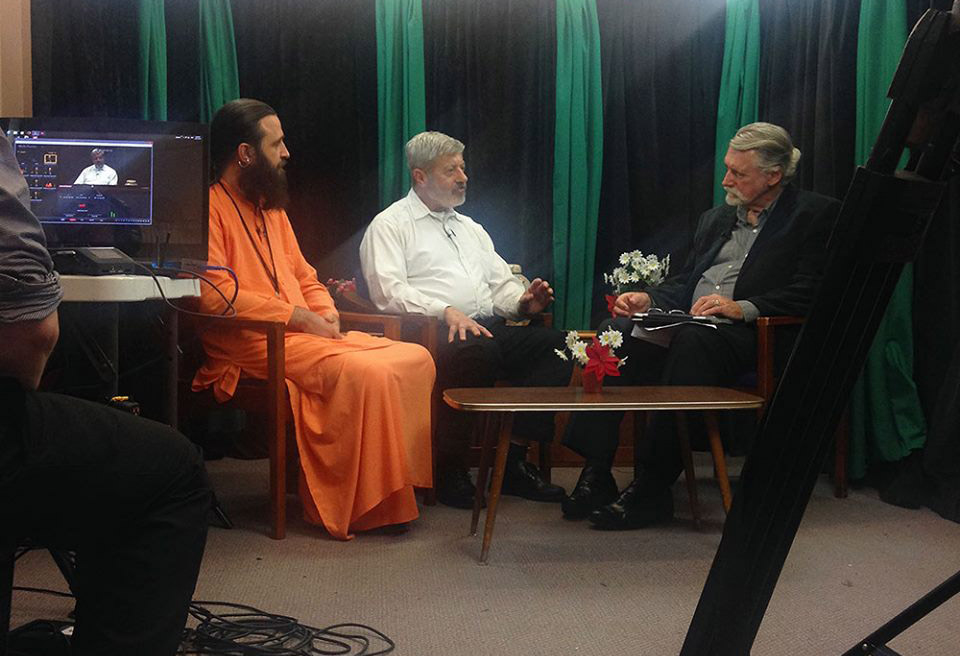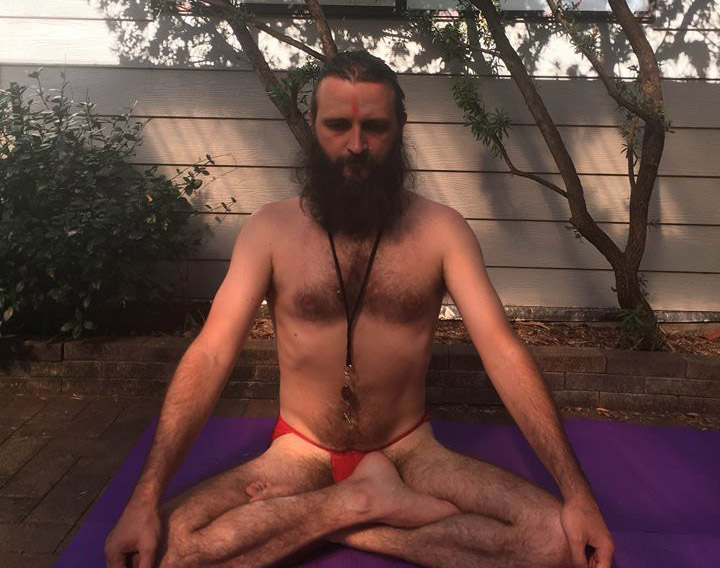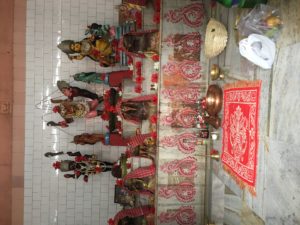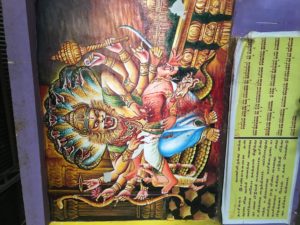I translated the tantric Gorakśanātha-upāsanā according to the Kalpadruma Tantra at the request of my students.
विनियोगः। viniyogaḥ ।
ॐ अस्य श्री गोरक्ष मन्त्रस्य बृहदारण्यक ऋषिः अनुष्टुप् छन्दः श्री गोरक्षनाथो देवता गों बीजम् विमला शक्तिः हंसेति कीलकं निरञ्जनात्मक सर्व तत्त्व सिद्धये जपे विनियोगः ।।
oṃ asya śrī gorakṣa mantrasya bṛhadāraṇyaka ṛṣiḥ anuṣṭup chandaḥ śrī gorakṣanātho devatā goṃ bījam vimalā śaktiḥ haṃseti kīlakaṃ nirañjanātmaka sarva tattva siddhaye jape viniyogaḥ ।।
The ṛṣi of the Śrī gorakṣanātha–mantra is Bṛhadāraṇyaka, the rhythm is anuṣṭup, the Divine is Gorakṣanātha, the bija is goṃ, the Śakti is Vimalā (pure), the kīlaka is haṃsa, the ritual of japa for success in the essential purity of all tattvas.
ऋष्यादिन्यासः । ṛṣyādinyāsaḥ । (the nyāsa starts from the head and so on)
ॐ बृहदारण्यक ऋषये नमः। शिरसि ।
oṃ bṛhadāraṇyaka ṛṣaye namaḥ । śirasi (touch the crown of the head)
ॐ अनुष्टुप् छन्दसे नमः । मुखे ।
oṃ anuṣṭup chandase namaḥ । mukhe (the face)
ॐश्री गोरक्ष देवताय नमः । हृदि ।
oṃ śrī gorakṣa devatāya namaḥ । hṛdi (the heart)
ॐ गो बीजाय नमः । गुह्ये ।
oṃ go bījāya namaḥ । guhye (the perineum)
ॐ विमला शक्तये नमः । पादयोः ।
oṃ vimalā śaktaye namaḥ । pādayoḥ (the feet)
ॐ हंसेति कीलकाय नमः । नाभौ ।
oṃ haṃseti kīlakāya namaḥ । nābhau (the navel)
करन्यासः । karanyāsaḥ । (the palm nyāsa)
ॐ ह्रीं श्रीं गों गोरक्षनाथाय अङ्गुष्टाभ्यां नमः ।
oṃ hrīṃ śrīṃ goṃ gorakṣanāthāya aṅguṣṭābhyāṃ namaḥ । (connect two thumbs of your hands)
ॐ ह्रीं श्रीं गों गोरक्षनाथाय तर्जनीभ्यां नमः ।
oṃ hrīṃ śrīṃ goṃ gorakṣanāthāya tarjanībhyāṃ namaḥ । (connect two index fingers)
ॐ ह्रीं श्रीं गों गोरक्षनाथाय मध्यमाभ्यं नमः ।
oṃ hrīṃ śrīṃ goṃ gorakṣanāthāya madhyamābhyaṃ namaḥ । (connect the two middle fingers)
ॐ ह्रीं श्रीं गों गोरक्षनाथाय अनामिकाभ्यां नमः ।
oṃ hrīṃ śrīṃ goṃ gorakṣanāthāya anāmikābhyāṃ namaḥ । (connect two ring fingers)
ॐ ह्रीं श्रीं गों गोरक्षनाथाय कनिष्ठिकाभ्यं नमः ।
oṃ hrīṃ śrīṃ goṃ gorakṣanāthāya kaniṣṭhikābhyaṃ namaḥ । (connect two little fingers)
ॐ ह्रीं श्रीं गों गोरक्षनाथाय करतल-कर-पृष्ठाभ्यां नम: ।
oṃ hrīṃ śrīṃ goṃ gorakṣanāthāya karatala-kara-pṛṣṭhābhyāṃ namaḥ । (connect the back of the palms)
हृदयादिन्यासः । hṛdayādinyāsaḥ । (nyāsa starts from the heart and etc.)
ॐ ह्रीं श्रीं गों गोरक्षनाथाय हृदयाय नमः ।
oṃ hrīṃ śrīṃ goṃ gorakṣanāthāya hṛdayāya namaḥ । (touch the heart)
ॐ ह्रीं श्रीं गों गोरक्षनाथाय शिरसे स्वाहा ।
oṃ hrīṃ śrīṃ goṃ gorakṣanāthāya śirase svāhā । (touch the head)
ॐ ह्रीं श्रीं गों गोरक्षनाथाय शिखायै वषट् ।
oṃ hrīṃ śrīṃ goṃ gorakṣanāthāya śikhāyai vaṣaṭ । (touch the crown of the head)
ॐ ह्रीं श्रीं गों गोरक्षनाथाय कवचाय हुं ।
oṃ hrīṃ śrīṃ goṃ gorakṣanāthāya kavacāya huṃ । (touch your shoulders)
ॐ ह्रीं श्रीं गों गोरक्षनाथाय नेत्रत्रयाय वौषट् ।
oṃ hrīṃ śrīṃ goṃ gorakṣanāthāya netratrayāya vauṣaṭ । (touch three eyes)
ॐ ह्रीं श्रीं गों गोरक्षनाथाय सर्व विद्यापतये नमः अस्त्राय फट् ।
oṃ hrīṃ śrīṃ goṃ gorakṣanāthāya sarva vidyāpataye namaḥ astrāya phaṭ ।
(circle with your right hand above your head clockwise and hit the left palm with index and middle fingers three times)
अथ ध्यानम् । atha dhyānam । (now is dhyāna)
(The text from the Kalpadruma Tantra)
निरञ्जनो निराकारो निर्विकल्पो निरामयः।
अगम्योऽगोचरोऽलक्ष्यो गोरक्षः सिद्धिवन्दितः॥
nirañjano nirākāro nirvikalpo nirāmayaḥ।
agamyo’gocaro’lakṣyo gorakṣaḥ siddhivanditaḥ॥
Unsullied, devoid of image, free from vikalpas and disease, incomprehensible, unattainable, beyond of the symbols – Gorakṣa, revered by the siddhas.
समस्त रस भोक्ता यो यः सदा भोगवर्जित ।
सदा समरसो यश्च श्री गोरक्षनमोऽस्तु ते ॥
samasta rasa bhoktā yo yaḥ sadā bhogavarjita ।
sadā samaraso yaśca śrī gorakṣanamo’stu te ॥
To Him, who enjoys all races and who is always free from pleasures, who forever abides in samarasya, may there be worship to you, Śrī Gorakṣa!
हठयोग विधाता च मत्स्यकीर्ति विवर्धनः ।
योगिभिर् मनसा गम्यः श्री गोरक्षनमोऽस्तु ते ॥
haṭhayoga vidhātā ca matsyakīrti vivardhanaḥ ।
yogibhir manasā gamyaḥ śrī gorakṣanamo’stu te ॥
To the creator of haṭhayoga and to that who increased the fame of Matsyendra, the one whom yogis comprehend in their hearts, may there be worship to you, Śrī Gorakṣa!
सिद्धानाञ्च महासिद्धिः ऋषीणां च ॠषीश्वरः ।
योगीनाङ्चैव योगीन्द्रः श्री गोरक्षनमोऽस्तु ते ॥
siddhānāñca mahāsiddhiḥ ṛṣīṇāṃ ca ṝṣīśvaraḥ ।
yogīnāṅcaiva yogīndraḥ śrī gorakṣanamo’stu te ॥
To the great siddha among the siddhas, to the lord of the ṛṣi among the ṛṣis, to the lord of the yogis among the yogis, may there be worship to you, Śrī Gorakṣa!
विश्वतेजो विश्वरूपं विश्ववन्द्य सदाशिवः ।
विश्वनामा विश्वनाथः श्री गोरक्षनमोऽस्तु ते ॥
viśvatejo viśvarūpaṃ viśvavandya sadāśivaḥ ।
viśvanāmā viśvanāthaḥ śrī gorakṣanamo’stu te ॥
Universal light manifested in the image of the Universe, revered by all, Sadāśiva, who is called by all kinds of names, the lord of everything, may there be worship to you, Śrī Gorakṣa!
अनन्तलोकनाथश्च नाथनाथशिरोमणिः।
सर्वनाथसमाराध्यः श्री गोरक्षनमोऽस्तु ते ॥
anantalokanāthaśca nāthanāthaśiromaṇiḥ।
sarvanāthasamārādhyaḥ śrī gorakṣanamo’stu te ॥
To the Lord of infinite worlds, the greatest (lit. “head precious adornment) of the Nāthas, to the Lord of all, to the one who is respected, may there be worship to you, Śrī Gorakṣa!
शून्यानाङ्च परं शून्यं परेषां परमेश्वरः ।
ध्यायताञ्च परं धाम श्री गोरक्षनमोऽस्तु ते ॥
śūnyānāṅca paraṃ śūnyaṃ pareṣāṃ parameśvaraḥ ।
dhyāyatāñca paraṃ dhāma śrī gorakṣanamo’stu te ॥
To the highest emptiness among the voids, to the Supreme Lord for others, to the highest state for the meditators, may there be worship to you, Śrī Gorakṣa!
Then you can practice japa using the mantras from the above tantras, they can be found here: http://matsyendranatha.com/?p=554:










